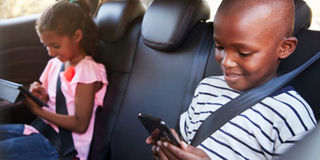Keeping children safe while driving

Unlike adults, children are sometimes some of the unruly passengers or occupants to control in your car.
Sometimes when you threaten to punish them, they appear and continue behaving as if you did not say anything.
Stuart Oramire, a motorist and parent says every time his children are in the car, he does not let any of them occupy the front or co-driver’s seat.
Let them use back seats
“I make sure they are seated in the rear seats and are wearing their seatbelts. If there is any of them below five years, there is a designated seat for them where they are confined and buckled up,” Oramire explains.
Anthony Katabazi, also a motorist and parent, observes that a car is a machine that can kill anyone, children inclusive, as a result of any carelessness. This involves letting them (children) stand in the co-driver’s seat as they hold or get support from the dashboard.
Avoid overloading the car with children
“Every vehicle was manufactured to carry a specific number of seats and passengers and these include children. When you load more children than the car stipulates, it is as good as sacrificing those that are not belted up in case of any accident. They will be ejected from the car through the windscreen.
As a motorist, you could be wearing your seatbelt and this means that you will survive and the children who will not have belted up will likely die if the accident is fatal,” Katabazi advises.
Drive with a helper
Of late, there is a trend of motorists who drive while carrying children on their laps. Along the way, the same motorists also start using their mobile phone.
This means that your mind and focus will be divided thrice; you will be partially focusing where you are driving to, partially focusing on your phone, a trend that escalates daily, and partially focusing on the baby or child you are carrying on your laps to ensure they are comfortable. The disadvantage with this is that it increases your chances of getting involved in accidents.
“If the child cannot fit in their designated child or baby seat, drive along with someone from home who will help you carry the child as you drive. They will help control and monitor the behaviour of the child and attend to them where need be,” Katabazi adds.
Instil discipline early
Shiba Nassuuna, a mother of three observes that instilling and modelling children into obedient kind of people as they grow up saves you the headache of having to fight with them in the car as they grow up. She is of a view that from the onset children start moving in the same car with you, once they know what they are expected of, none will disobey your car rules.
“When each of my children made two years, I made it clear to them that I would not start the car and the journey when they are not seated in the rear seats fitted in the children’s chair.
Their seats are also fitted with fitting seatbelts. That way, it was easier for them to understand that I wanted them seated and belted up later when they started school.
They became respectful and obedient of what I told them,” Nassuuna explains, adding that if any of her children becomes disobedient, they are aware of the punishment that comes with their behaviour.
Do not take your eyes off the prize
According to drivemag, an online portal, don’t take your eyes off the prize. That is, getting from A to B in complete safety, children included. Therefore, never leave your kids alone in the car whatever good reason you might think you have, but also teach them not to play with door and power window switches as well as not to sit on armrests. Also, make sure you never leave the key in ‘ignition’, ‘on’ or ‘accessory’ positions.
Beware of heatstroke
The portal also advises that children don’t handle heat as an adult’s body would. That’s one of the reasons why heatstroke is a common cause of child death. To prevent that, make a habit out of looking twice and checking the rear seats before locking the car and keep in mind that in 10 minutes under direct sunlight, the temperature inside a car can double.
Some of the symptoms related to heatstroke are red, hot and dry skin, nausea and the lack of sweating.



